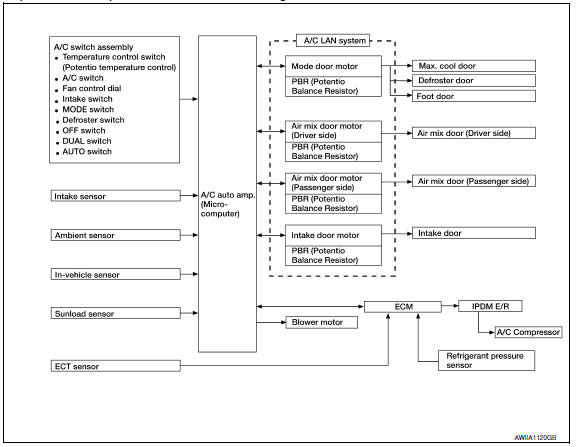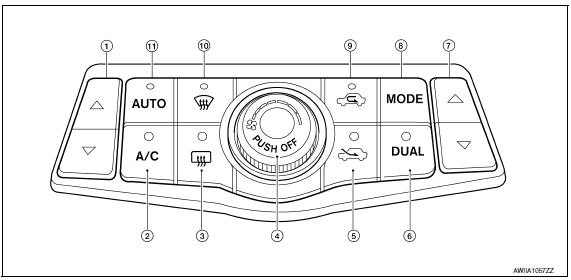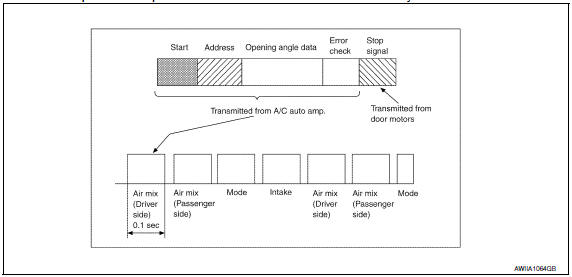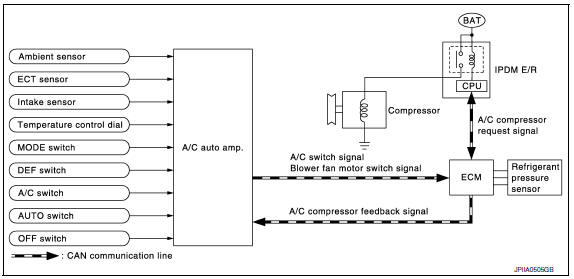Nissan Maxima Service and Repair Manual: Automatic air conditioner system
System Diagram
CONTROL SYSTEM
The control system consists of input sensors, switches, the A/C auto amp. (microcomputer) and outputs. The relationship of these components is as shown in the figure below:

System Description
CONTROL OPERATION
Display
The operation status of the HVAC system is displayed on the screen.

A/C Switch Assembly

- Temperature control switch (driver side)
- A/C ON/OFF switch
- Rear window defogger switch
- OFF switch/fan control dial
- Fresh air switch
- DUAL mode switch
- Temperature control switch (passenger side)
- Mode switch
- Recirculation switch
- Defroster switch
- AUTO switch
MODE SWITCH
The air discharge outlets are controlled with this switch.
TEMPERATURE CONTROL SWITCH (Driver Side)
The set temperature is increased or decreased with this switch.
TEMPERATURE CONTROL SWITCH (Passenger Side)
- The set temperature is increased or decreased with this switch.
- When the temperature control switch is pressed, DUAL mode indicator is turned ON.
AUTO SWITCH
- The A/C compressor, intake doors, air mix doors, mode doors and blower speed are automatically controlled so that the in-vehicle temperature will reach, and be maintained at the set temperature selected by the operator.
- When pressing the AUTO switch, air inlet, air outlet, fan speed, and discharge air temperature are automatically controlled.
DEFROSTER ( ) SWITCH
) SWITCH
Mode doors are set to the defrost position with this switch. Also, intake doors are set to the outside air position, and A/C compressor turns ON.
A/C SWITCH
A/C compressor turns ON or OFF with this switch.
(Pressing the A/C switch, when the A/C switch is ON, turns OFF the A/C switch and A/C compressor.)
FAN CONTROL DIAL
The fan speed is manually controlled with this dial. Seven speeds are available for manual control (as shown on the display screen).
OFF SWITCH
A/C compressor and blower turn OFF, intake doors and the mode doors are automatically controlled.
REAR WINDOW DEFOGGER SWITCH
When indicator is ON, rear window is defogged.
RECIRCULATION ( ) SWITCH
) SWITCH
- When the REC switch is ON, the REC switch indicator is turned ON, and air inlet is set to REC.
FRESH AIR ( ) SWITCH
) SWITCH
- When the FRE switch is ON, the FRE switch indicator is turned ON, and air inlet is set to FRE.
DUAL MODE SWITCH
- When the DUAL switch indicator is ON, the driver side and passenger side temperature can each be set independently.
- When the DUAL switch indicator is OFF, the driver side outlet and setting temperature are applied to both sides.
Air Conditioner LAN Control System
The LAN (Local Area Network) system consists of the A/C auto amp., the mode door motor, the air mix door motors and the intake door motor.
A configuration of these components is as shown in the figure below

SYSTEM CONSTRUCTION
A small network exists between the A/C auto amp., the mode door motor, the air mix door motors and the intake door motor. The A/C auto amp. and motors are connected by data transmission lines and motor power supply lines. The LAN network is built through the ground circuits of each door motor.
Addresses, motor opening angle signals, motor stop signals and error checking messages are all transmitted through the data transmission lines connecting the A/C auto amp. and each door motor.
The following functions are contained in LCUs built into the mode door motor, the air mix door motors and the intake door motor.
- Address
- Motor opening angle signals
- Data transmission
- Motor stop and drive decision
- Opening angle sensor (PBR function)
- Comparison
- Decision (A/C auto amp. indicated value and motor opening angle comparison)

Operation
The A/C auto amp. receives data from each of the sensors. The A/C auto amp. sends mode door, the air mix door and the intake door opening angle data to the mode door motor LCU, the air mix door motor LCUs and the intake door motor LCU.
The mode door motor, the air mix door motors and the intake door motor read their respective signals according to the address signal. Opening angle indication signals received from the A/C auto amp. and each of the motor position sensors is compared by the LCUs in each door motor with the existing decision and opening angles. Next, HOT/COLD, DEF/VENT or FRE/REC operation is selected. The new selection data is returned to the A/C auto amp.

TRANSMISSION DATA AND TRANSMISSION ORDER
A/C auto amp. data is transmitted consecutively to each of the door motors following the form as shown in the figure below.
START:
- Initial compulsory signal is sent to each of the door motors.
ADDRESS:
- Data sent from the A/C auto amp. is selected according to data-based decisions made by the mode door motor, the air mix door motors and the intake door motor.
- If the addresses are identical, the opening angle data and error check signals are received by the door motor LCUs. The LCUs then make the appropriate error decision. If the opening angle data has no error, door control begins.
- If an error exists, the received data is rejected and the corrected data is received. Finally, door control is based upon the corrected opening angle data.
OPENING ANGLE:
- Data that shows the indicated door opening angle of each door motor.
ERROR CHECK:
- In this procedure, transmitted and received data is checked for errors. Error data is then compiled. The error check prevents corrupted data from being used by the mode door motor, the air mix door motors and the intake door motor. Error data can be related to the following symptoms:
- Malfunction of electrical frequency
- Poor electrical connections
- Signal leakage from transmission lines
- Signal level fluctuation
STOP SIGNAL:
- At the end of each transmission, a stop operation, in-operation, or internal malfunction message is delivered to the A/C auto amp. This completes one data transmission and control cycle.

AIR MIX DOOR CONTROL (AUTOMATIC TEMPERATURE CONTROL)
- The air mix doors are automatically controlled so that in-vehicle temperature is maintained at a predetermined value by the temperature setting, ambient temperature, in-vehicle temperature and amount of sunload.
FAN SPEED CONTROL
- Fan speed is automatically controlled by the temperature setting,
ambient temperature, in-vehicle temperature,
intake temperature, amount of sunload and air mix door position.
With pressing AUTO switch, the blower motor starts to gradually increase air flow volume.
When engine coolant temperature is low, the blower motor operation is delayed to prevent cool air from flowing.
INTAKE DOOR CONTROL
- The intake doors are automatically controlled by the temperature setting, ambient temperature, in-vehicle temperature, intake temperature, amount of sunload and ON/OFF operation of the compressor.
MODE DOOR CONTROL
- The mode door is automatically controlled by the temperature setting, ambient temperature, in-vehicle temperature, intake temperature and amount of sunload.
MAGNET CLUTCH CONTROL

When A/C switch, AUTO switch or DEF ( ) switch is pressed, A/C auto amp. transmits compressor ON signal
to ECM, via CAN communication.
) switch is pressed, A/C auto amp. transmits compressor ON signal
to ECM, via CAN communication.
ECM judges whether compressor can be turned ON, based on each sensor status (refrigerant pressure sensor signal, throttle angle, etc.). If it judges compressor can be turned ON, it sends compressor ON signal to IPDM E/R, via CAN communication.
Upon receipt of compressor ON signal from ECM, IPDM E/R turns air conditioner relay ON to operate compressor.
When sending compressor ON signal to IPDM E/R via CAN communication line, ECM simultaneously sends compressor feedback signal to A/C auto amp. via CAN communication line.
 Compressor control function
Compressor control function
Description
PRINCIPLE OF OPERATION
A/C compressor is not activated.
Functional circuit diagram
CAN (1): A/C switch signal
: Blower fan motor switch signal
CAN (2): A/C compressor request sig ...
 Mode door control system
Mode door control system
System Diagram
System Description
The mode door is automatically controlled by the temperature setting, ambient
temperature, in-vehicle temperature,
intake temperature and amount of sunload.
...
Other materials:
U121D AV control unit
DTC Logic
Diagnosis Pro
1.CHECK PLAYBACK OF A DISK (CD)
U121E AV CONTROL UNIT
DTC Logic
Diagnosis Procedure
1.CHECK PLAYBACK OF A DISK (CD)
U1225 AV CONTROL UNIT
DTC Logic
DTC DETECTION LOGIC
...
Secondary speed sensor
Exploded View
Secondary speed sensor
Shim
Transaxle assembly
O-ring
Apply CVT Fluid NS-2
Removal and Installation
REMOVAL
Disconnect the battery negative terminal. Refer
to PG-67, "Removal and Installation (Battery)" ...
Climate controlled seat switches (if so equipped)
The climate controlled seat warms up or cools
down the front seat by blowing warm or cool air
from under the surface of the seat. The climate
control switch is located on the center console.
The climate controlled seat can be operated as
follows:
1. Start the engine.
2. Turn the contr ...
Nissan Maxima Owners Manual
- Illustrated table of contents
- Safety-Seats, seat belts and supplemental restraint system
- Instruments and controls
- Pre-driving checks and adjustments
- Monitor, climate, audio, phone and voice recognition systems
- Starting and driving
- In case of emergency
- Appearance and care
- Do-it-yourself
- Maintenance and schedules
- Technical and consumer information
Nissan Maxima Service and Repair Manual
0.007
